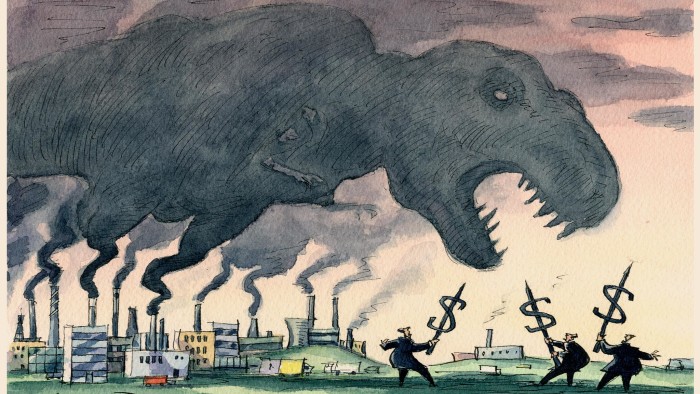Why climate uncertainty justifies action


Roula Khalaf, Editor of the FT, selects her favourite stories in this weekly newsletter.
Is there any significant likelihood that policy action will eliminate the risk of climate disaster? At present, the answer is no.
This is so, even though leaders of the group of seven leading high-income countries say they support cutting emissions by 40 to 70 per cent by 2050. It is so, even though a major global conference in Paris at the end of the year aims to reach a universal and legally binding agreement, enabling “us to combat climate change effectively” and boost the transition towards “resilient, low-carbon societies and economies”.
Why should we be sceptical? The answer is that we have heard similar commitments for nearly a quarter of a century; and yet we have only seen rising flows of emissions and stocks of greenhouse gases in the atmosphere. Even if governments met current commitments (itself unlikely), atmospheric concentrations of carbon dioxide would rise towards 700 parts per million by the end of the century, as against 280 ppm before the industrial revolution and some 400 ppm now. With 700 ppm, the median increase in expected global temperature is 3.5C. Keeping emissions on the path needed to limit the median expected increase to the recommended 2C — and then delivering — would require a revolution. (See chart)
Climate Shock, a punchy new book by Gernot Wagner of the Environmental Defense Fund and Martin Weitzman of Harvard University, explains why action is both so difficult and so important. The challenge is “almost uniquely global, uniquely long-term, uniquely irreversible and uniquely uncertain”. The book’s big contribution is on the last point: uncertainty. Climate change is a problem of insurance. For this, it is not median outcomes that matter most, but the outliers — the “fat tails” of the probability distribution of temperature.
As concentrations of greenhouse gases rise, scientists argue, so do median expected increases in temperature and, crucially, the likelihood of extreme outcomes. At 400 ppm, the chances of a 6C rise are near zero. At 550 ppm, the chances are only 3 per cent. But at 700 ppm, they may exceed one in 10. This distribution is itself uncertain, as are possible economic costs. But, on the path we are now on, we have a significant chance of transforming the world into something not seen for tens of millions of years, with uncertain, but potentially devastating consequences.
If you had a 10 per cent chance of losing most of your wealth, would you keep the same portfolio? For the vast majority, the answer would be a loud “no”. You would insure yourself against such a disaster. We cannot insure ourselves with the inhabitants of Mars against the chance that we are wrecking our planetary home. But we can lower the risks.
Climate uncertainty relates to the future. This makes discounting inescapable, to relate costs (and benefits) over time. So what discount rate should be employed? Here Climate Shock makes another crucial point: we do not know. But, it adds, the uncertainty suggests the right rate is likely to be very low.
In depth

The latest news and analysis on the world’s changing climate and the political moves afoot to tackle the problem
Further reading
Conventionally, the real discount rate is set at 3 to 4 per cent. Controversially, Lord Stern used 1.4 per cent in the groundbreaking review on global warming that he produced for the UK government in 2006. The higher figures are based on assumptions about the opportunity cost of capital. The lower one is based on assumptions about the value of future lives (assumed, rightly, to be similar to the value of our own).
So which approach is right? The answer is: neither. Both are too precise. The authors suggest the “primary driver for low discount rates is uncertainty around the correct discount rate itself”. One reason is uncertainty about the future, independent of climate change: we do not know the return on capital over a century. Moreover, the discount rate cannot be independent of the risk of catastrophic climate change. Maybe, future generations will not be far richer than us, for just this reason.
Crucially, they note, people currently buy bonds yielding zero in real terms. They do so because they want protection against catastrophic states of a highly uncertain world — maybe a crash far worse than 2008. Indeed, we now understand that this largely explains the “equity risk premium puzzle” — the fact that the expected return on equities is vastly higher than on safe bonds. If people will accept super-low returns as the price of insuring against catastrophe, then that should also apply to climate. Thus, conclude the authors, the right discount rate for projects that ought to eliminate the tail risks could be very low, maybe even negative.
Framing the challenge of climate change as a problem of insurance against disaster is intellectually fruitful. It also provides the right answer to sceptics. The question is not what we know for sure. The question is rather how certain we are (or can be) that nothing bad will happen. Given the science, which is well established, it is impossible to argue that we know the risks are small. This being so, taking action is logical. It is the right way to respond to the nature and scale of possible bad outcomes.
The authors suggest that the very least we need to do is impose a global price on emissions of CO2 at $40 a tonne (well above that delivered even by the EU Emissions Trading System). Now, however, the actual cost imposed on emissions is closer to minus $15 per tonne, because of vast subsidies to fossil fuel energy amounting to $550bn a year.
Hitherto, all the climate conferences have been almost Shakespearean — tales “told by an idiot full of sound and fury signifying nothing”. So could anything actually change our trajectory? It is increasingly evident that the answer has to be technological. Humanity is unwilling, possibly simply unable, to overcome the political, economic and social obstacles to collective action. The costs to current generations seem too daunting. So those costs have to fall.
Comments